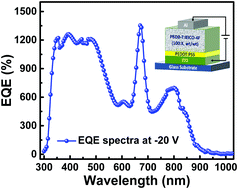Broadband organic photodetectors exhibiting photomultiplication with a narrow bandgap non-fullerene acceptor as an electron trap†
Abstract
Broadband organic photodetectors with photomultiplication (PM-OPDs) can be realized in the device structures of ITO/PEDOT:PSS/active layers/Al, where the active layers contain one broad bandgap polymer PDBD-T and a much lower amount of the ultra-narrow bandgap material, IEICO-4F. The active layers have an efficient single carrier (hole) transport property, leading to the low dark current of the PM-OPDs. The rather low amount of IEICO-4F surrounded by PBDB-T will become some isolated electron traps due to their differences in the lowest unoccupied molecular orbital levels. The photogenerated holes will be efficiently transported along the channels formed by PBDB-T, and the photogenerated electrons will prefer to be trapped in the isolated IEICO-4F. The trapped electrons in IEICO-4F near the Al electrode will induce interfacial band bending for the hole tunneling injection, achieving the photomultiplication phenomenon. The optimal PM-OPDs with PBDB-T : IEICO-4F (100 : 3, wt/wt) as active layers exhibited an external quantum efficiency (EQE) of >100% in the spectral range from 310 nm to 850 nm. The EQE of PM-OPDs can reach 1350% at 675 nm and 400% at 850 nm under −20 V bias. The ultra-narrow bandgap material IEICO-4F plays vital roles in realizing the PM phenomenon and extending the near infrared spectral response range.



 Please wait while we load your content...
Please wait while we load your content...